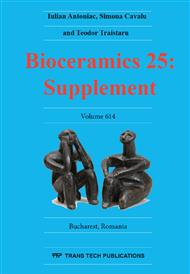p.140
p.144
p.148
p.157
p.163
p.168
p.173
p.178
p.183
Bone Substitute Used in a Bilateral Calcaneal Fracture-Case Presentation
Abstract:
Modern traumatology is characterized by high energy trauma, simultaneously affecting parts of the body especially in young patients. One of the most severe aspects resulting of high energy trauma is that of multiple skeletal injuries, with bone loss, which require complex treatment; this refers both to methods of filling the bone defects and to interdisciplinary approach whenever soft tissues are injured, as well. This case demonstrate the impact of modern approach in high energy trauma, with multiple aspects: bone substitutes as effective technique of bone filling and prevention of septic complications, as well as team work for concomitant treatment of associated injuries. The outcome of the patient, compared to the initial status, demonstrate the benefit of bone substitutes for a rapid recovery of trauma patients, with major impact on social and professional recovery.
Info:
Periodical:
Pages:
163-167
Citation:
Online since:
June 2014
Price:
Сopyright:
© 2014 Trans Tech Publications Ltd. All Rights Reserved
Share:
Citation:


